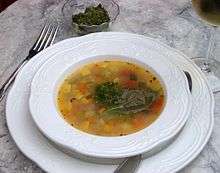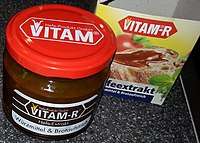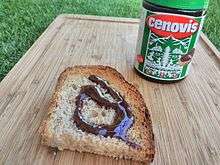Yeast extract
Yeast extracts consist of the cell contents of yeast without the cell walls;[3] they are used as food additives or flavorings, or as nutrients for bacterial culture media. They are often used to create savory flavors and umami taste sensations,[4] and can be found in a large variety of packaged food,[5] including frozen meals, crackers, snack foods, gravy, stock and more. They are rich in B vitamins (but not B12), and so are of particular importance to vegans and vegetarians. Yeast extracts and fermented foods contain glutamic acid (free glutamates), an amino acid which adds an umami flavor. Glutamic acid is found in meat, cheese, fungi (mushrooms), and vegetables—such as broccoli, and tomatoes.[6][7]

Yeast extracts in liquid form can be dried to a light paste or a dry powder (but this is not the same as nutritional yeast).[8]
The process to make yeast extract was invented in the 19th century by Justus von Liebig.[9] Yeast cells are heated until they rupture, then the cells' own digestive enzymes break their proteins down into simpler compounds (amino acids and peptides), a process called autolysis.[10] The insoluble cell walls are then separated by centrifuge, filtered, and usually spray-dried.[11]
Use in foods

Yeast autolysates are used in AussieMite, Mightymite, Vegemite, Marmite, New Zealand Marmite, Promite, Cenovis, Vitam-R, Cenovit and Maggi sauce.[12][13][14] Bovril (Ireland and the United Kingdom) switched from beef extract to yeast extract for 2005 and most of 2006, but later switched back.[15]
Yeast extract is produced commercially by heating a suspension of yeast; the enzymes in the yeast cell then degrade the cell wall. The result has more concentrated flavor and a different texture. This is the process used for Vegemite, Marmite, and the like.[8]
Yeast extract is used as a flavoring in foods. It is a common ingredient in American barbecue-flavored potato chips such as Lay's.[16]
Marmite
| Inventor | Justus von Liebig |
|---|---|
| Inception | 1902 |
| Current supplier | Unilever |
Marmite (/ˈmɑːrmaɪt/ MAR-myte) is a British food spread produced by Unilever. Marmite is made from yeast extract, a by-product of beer brewing. Marmite has been produced since 1902.
Marmite is a sticky, dark brown food paste with a distinctive, powerful flavour, which is extremely salty. This distinctive taste is represented in the marketing slogan: "Love it or hate it." Such is its prominence in British popular culture that the product's name is often used as a metaphor for something that is an acquired taste or tends to polarise opinions.[17][18]
The image on the front of the jar shows a "marmite" (French: [maʁmit]), a French term for a large, covered earthenware or metal cooking pot. Marmite was originally supplied in earthenware pots, but since the 1920s has been sold in glass jars.
Marmite has been manufactured in New Zealand since 1919 under license, but with a different recipe, see "Marmite (New Zealand)". This is the only product sold as Marmite in Australasia and the Pacific, whereas elsewhere in the world the British version predominates.
Vegemite
Vegemite (/ˈvɛdʒɪmaɪt/ VEJ-i-myte)[19][20] is a thick, black Australian food spread made from leftover brewers' yeast extract with various vegetable and spice additives. It was developed by Cyril Percy Callister in Melbourne, Victoria in 1922. The Vegemite brand was owned by Mondelez International (formerly Kraft Foods Inc.)[21] until January 2017, when it was acquired by the Australian Bega Cheese group in a US$460,000,000 (equivalent to about $480,000,000 in 2019) agreement for full Australian ownership after Bega would buy most of Mondelez International's Australia and New Zealand grocery and cheese business.[22]
A spread for sandwiches, toast, crumpets and cracker biscuits as well as a filling for pastries, Vegemite is similar to British Marmite, New Zealand Marmite, Australian Promite, MightyMite, AussieMite, OzEmite, German Vitam-R, and Swiss Cenovis.
Vegemite is salty, slightly bitter, malty, and rich in glutamates – giving it an umami flavour similar to beef bouillon. It is vegan, kosher, and halal.[23]
Vitam-R
 | |||||||
| Type | Yeast spread | ||||||
|---|---|---|---|---|---|---|---|
| Place of origin | Germany | ||||||
| Invented | 1925 | ||||||
| Main ingredients | Yeast extract | ||||||
| Variations | Kräuter (Herbs) | ||||||
| 223 kcal (934 kJ) | |||||||
| |||||||
| Similar dishes | Marmite, Vegemite | ||||||
Vitam-R is a savory yeast extract spread made in Hameln, Germany, by the company Vitam Hefe-Produkt GmbH. It was first developed by Rückforth AG in Stettin (today's Szczecin, Poland) in 1925[24][25] following the discovery by Justus von Liebig that yeast could be concentrated.[26] It is sometimes described as having a smoother flavor than similar products such as Marmite,[27] Vegemite or Cenovis. Unlike those brands, Vitam-R is not an iconic part of its home country's cuisine, but it is also described as having a love-it-or-hate-it flavor.[28] It is both vegan and vegetarian and is sold primarily in Reformhaus health-food stores.[24]
Cenovis
 Cenovis on bread, with jar in the background | |
| Type | Spread |
|---|---|
| Place of origin | Switzerland |
| Region or state | Rheinfelden |
| Created by | Alex Villinger |
| Invented | 1931 |
| Main ingredients | Yeast extract |
Cenovis is a product based on yeast extract that is similar to Marmite and Vegemite, rich in vitamin B1. In the form of a dark brown food paste, it is used to flavour soups, sausages and salads. The most popular way to consume Cenovis, however, is to spread it on a slice of buttered bread, as stated on the product's packaging (or it can be blended into the butter and spread on bread or as a filling in croissants and buns).
Cenovis is popular in Switzerland (particularly Romandie). It was developed in Rheinfelden in 1931, on the initiative of a master brewer called Alex Villinger,[29] and was subsequently produced by the company Cenovis SA.
See also
References
- "Handcrafted chicken soup doesn't happen in 30 minutes, but it can take less work than you might think". National Post. 17 April 2017. Retrieved 27 September 2018.
- "Campbell Rethinks Its Soup Recipe as Consumer Tastes Change". The New York Times. 10 November 2015. Retrieved 27 September 2018.
- Umami: Unlocking the Secrets of the Fifth Taste. Arts and Traditions of the Table: Perspe. Columbia University Press. 2014. p. 172. ISBN 978-0-231-16890-8. Retrieved 27 September 2018.
- Baines, D.; Seal, R. (2012). Natural Food Additives, Ingredients and Flavourings. Woodhead Publishing Series in Food Science, Technology and Nutrition. Elsevier Science. p. 296. ISBN 978-0-85709-572-5. Retrieved 27 September 2018.
- Costello, Rose (21 March 2013). "Do you really know what exactly is in your frozen chips?". The Irish Times. Retrieved 27 September 2018.
- "Your guide to glutamate (+vegan queso salsa dip)". WhyFoodWorks. Retrieved 15 April 2016.
- Renton, Alex (10 July 2005). "If MSG is so bad for you, why doesn't everyone in Asia have a headache?". the Guardian. Retrieved 6 April 2018.
- Bond, Owen. "Benefits of Yeast Extract". Livestrong.com. Retrieved 4 April 2018.
- https://www.telegraph.co.uk/foodanddrink/foodanddrinknews/8922483/Marmite-profile-of-a-yeast-based-spread.html
- "Here's how food companies sneak MSG into foods". Business Insider. Retrieved 5 April 2018.
- George A. Burdock, Encyclopedia of Food and Color Additives 3:2972, CRC Press, 1997, ISBN 0849394147
- Frawley, Francesca (13 October 2016). "Having a Marmite CRISIS? Here are the tasty alternatives (and it doesn't involve Bovril)". Express.co.uk. Retrieved 5 April 2018.
- "Vegemite, Marmite, Promite - which is best?". Stuff. Retrieved 5 April 2018.
- Barton, Laura (4 January 2002). "100 years of Marmite". the Guardian. Retrieved 5 April 2018.
- Wainwright, Martin (19 November 2004). "Bovril drops the beef to go vegetarian". the Guardian. Retrieved 5 April 2018.
- "Lay's Barbecue Flavor Potato Chips Ingredients". Retrieved 7 June 2018.
- Hodsdon, Amelia (22 April 2010). "How Marmite spread its way through journalism". The Guardian. Retrieved 26 June 2014.
- Gabbatt, Adam (13 October 2016). "Marmite: Americans wonder what's all the fuss over divisive British spread?". The Guardian. Retrieved 16 March 2017.
- Macquarie Dictionary, Fourth Edition (2005). Melbourne, The Macquarie Library Pty Ltd. ISBN 1-876429-14-3
- vegemite. Dictionary.com Unabridged (v 1.1). Random House. 4 May 2009.
- "The Vegemite Story". Kraft Foods.
- "Vegemite bought by Bega from US food giant Mondelez International – ABC Rural – ABC News (Australian Broadcasting Corporation)". ABC News. 19 January 2017. Retrieved 19 January 2017.
- "FAQs - Start with VEGEMITE". vegemite.com.au. Retrieved 21 November 2018.
- "Vitam: Mit Hefe-Extrakt zum Welthersteller". Bio-markt.info. Bio-Markt.info: Das Nachrichtenportal der Naturkostbranche. 1 September 2009. Retrieved 12 September 2018.
Beispielhaft für den wissensbezogenen Wandel der Vermarktung steht Vitam-R, ein Hefeextrakt, der Ende der 1920er Jahre als »Fleischextrakt des Vegetariers«39 vermarktet wurde. Das Präparat wurde 1925 von der Stettiner Rückforth AG...
- Uwe Spiekermann (14 May 2018). Künstliche Kost: Ernährung in Deutschland, 1840 bis heute. Vandenhoeck & Ruprecht. pp. 407–. ISBN 978-3-647-31719-9.
- Boulton, Chris, ed. (2012). Encyclopedia of brewing. Weinheim: Wiley. p. 394. ISBN 978-1-4051-6744-4. Retrieved 4 November 2014.
- "Tesco takes Marmite off virtual shelves amid Brexit price hikes". dw.com. Deutsche Welle. 12 October 2016. Retrieved 12 September 2018.
But if Marmite stays off the shelves, Germany could have an answer. A company in Hameln has been making Vitam-R yeast spread since the 1920s. It may not have the same cachet as Marmite, but its smoother taste has a cult following among health food aficionados. But it, too, has become more expensive to import to Britain - even if, after Brexit, it will by default become the leading brand in the EU.
- Angela Helmberger (24 May 2018). Glücklich trotz Unverträglichkeiten: Rotationsdiät: Bauchschmerzen und Nahrungsmittelunverträglichkeiten dauerhaft lindern — Reizdarm und chronisch entzündlichen Darmerkrankungen vorbeugen. tredition. pp. 104–. ISBN 978-3-7469-4482-1.
- "Lorsqu'on allie la saveur à la santé ..." [When one combines flavour with health...]. Cenovis.ch. 1999. Archived from the original on 9 March 2011. Retrieved 27 February 2011. (French)
Further reading
- Herbst, Sharon (2001). Food Lover's Companion. Hauppauge, New York: Barron's Educational Series, Inc.
External links
- yeastextract.info: Homepage of Eurasyp (European Association of Specialty Yeast Products)
- http://savorytastealliance.com: Savory Taste Alliance